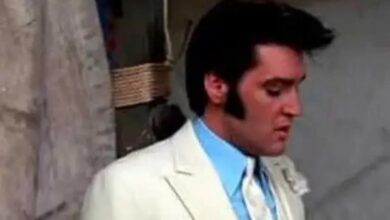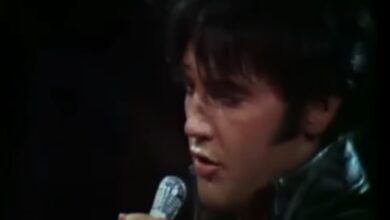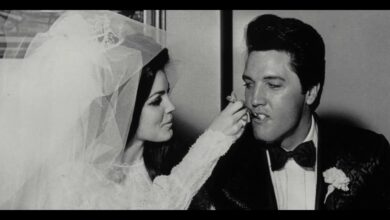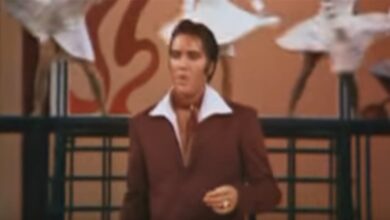Elvis’s Performance Revolutionized Music Forever
Elvis Presley’s performance of “Hound Dog” on the Milton Berle Show in June 1956 remains a pivotal moment in the trajectory of rock and roll history. At a time when television was becoming the primary medium for entertainment and pop culture, this performance managed to capture the attention of a nation and solidify Elvis’ status as a cultural icon. The combination of the song’s infectious rhythm and Elvis’ dynamic stage presence transformed not only the song’s legacy but also the music scene as a whole.
“Hound Dog” was originally penned by the songwriting duo Jerry Leiber and Mike Stoller, who were instrumental in shaping the sound of rhythm and blues in the early 1950s. The song was first recorded by Big Mama Thornton, whose powerful rendition conveyed deep emotion and raw energy. However, it was Elvis’ version, released in 1956, that propelled the song into the mainstream and into the hearts of millions. His interpretation brought a new flavor to the track, infusing it with a youthful exuberance that resonated with a generation eager for change.
On the Milton Berle Show, Elvis’ entrance was nothing short of electrifying. Berle, known for his comedy chops, introduced Presley with a mix of reverence and showmanship, setting the stage for a performance that would be forever remembered. Elvis greeted the audience with a swagger that effortlessly captivated viewers at home and those in the studio. As the opening chords of “Hound Dog” rang out, the anticipation in the air was palpable, and when he started to sway, it became evident that he was not just singing a song; he was putting on a show.
The choreography was equally groundbreaking. Elvis’ hip movements, often referred to as “the pelvic thrust,” were seen as provocative by conservative viewers but were embraced by the youth who saw him as a symbol of rebellion and freedom. This expression of physicality added a new dimension to rock and roll that had not been seen before on television. Critics of the time often chastised him for being too bold, while audiences couldn’t get enough, leading to mixed responses from different demographic sectors.
Throughout the performance, Elvis showcased his vocal prowess. His deep, resonant voice cut through the din of the accompanying instruments, and the raw, gritty inflections he introduced added layers of charisma and attitude. The backing band elevated the entire experience, featuring a tight rhythm section complemented by wailing saxophones that punctuated the upbeat tempo of the song. This amalgamation of sound was not only a testament to his talent but also to the vibrant musical landscape that he was part of.
As the cameras panned to the audience, the sheer exhilaration was evident. Young fans screamed in delight, while older generations looked on in a mix of astonishment and disapproval. Elvis had managed to capture a demographic divide; he was both adored and criticized, emblematic of the social changes that were occurring across America during that era. The performance not only resonated musically but also symbolized a cultural shift, as his music began to blur racial lines and introduced elements of rhythm and blues to broader audiences.
Elvis Presley’s impact was multifaceted. Aside from popularizing rock and roll, his image and performances challenged societal norms and expectations of masculinity. The blend of rebellion, sexual suggestion, and excitement in his performances was revolutionary and contributed to the shifting perceptions of youth culture in the 1950s and beyond. This performance was a cultural watershed, suggesting a new era in which youth would take center stage in music and popular culture.
Milton Berle’s encouragement of Elvis also played a key role in amplifying his visibility. Television was rapidly becoming an important platform for music promotion, and Berle, as a prominent figure on the airwaves, used his show to highlight emerging talents. By featuring Elvis, Berle not only showcased a new musical genre but also acknowledged the changing tastes of American audiences, setting a precedent for future interactions between television and the music industry.
As time went on, “Hound Dog” became one of Elvis’ signature songs, firmly establishing him as the “King of Rock and Roll.” The performance on the Milton Berle Show is often cited as a catalyst for his burgeoning career, leading to a series of chart-topping hits and successful films. The legendary status he went on to achieve can often be traced back to that single performance—a moment that encapsulated the fervor of rock and roll and the transformative power of popular music.
Elvis Presley, born on January 8, 1935, in Tupelo, Mississippi, would later go on to revolutionize the music industry, selling over a billion records worldwide. He was not just a singer but a cultural phenomenon whose influence permeated various aspects of entertainment, from music to film. The fusion of various genres such as country, blues, and gospel in his music laid the groundwork for the rock and roll genre, inspiring countless artists. His legacy is felt to this day, with many regarding him as the most significant cultural icon of the 20th century.
Ultimately, the legacy of Elvis Presley and his performance of “Hound Dog” on the Milton Berle Show transcends entertainment. This moment highlighted the power of music to not only entertain but to challenge norms, encourage change, and unite diverse groups of people through a shared passion. It marked the beginning of a new chapter in American music history, one that continues to influence artists and fans around the globe.



